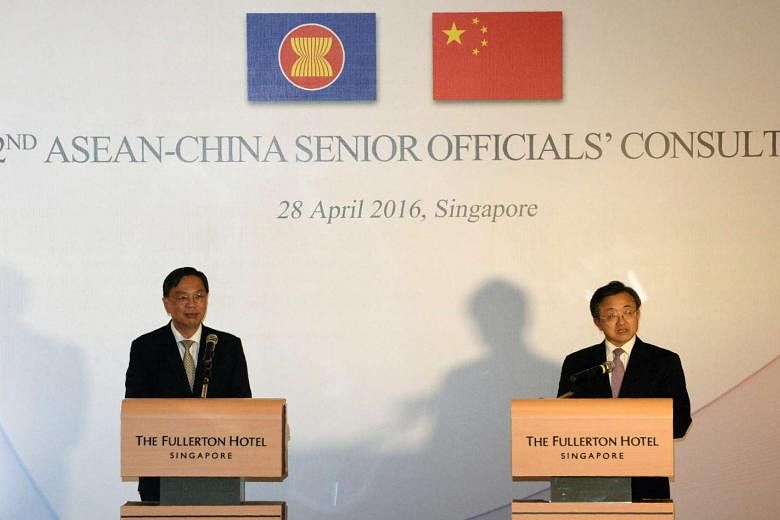When China attended the Asean meeting in Kuala Lumpur for the first time in 1991, nobody could have predicted that China-Asean relations would grow from strength to strength.
Over 25 years, both sides have enjoyed the most unprecedented relations and cooperation rarely seen in the grouping's external relations. Their ties have transformed into one of the most important bilateral ties among 11 dialogue partners.
The progress in Asean-China relations is no fluke, as they have worked hard to nurture their relationship. In the beginning, Asean and China had a mutual need.
Beijing's preferential treatment for Asean helped forge closer ties and vice versa.
In retrospect, the Asian economic crisis, the Sars pandemic, and humanitarian and disaster assistance both in China and Asean were some of the hallmarks of their cooperation.
Today, China and Asean are more confident and they enjoy a higher regional and international profile.
In general, Asean members are also more vocal and assertive, as their economy grows stronger and their security networks spread wider.
As the world's second-largest economy, China's political power is also rising.
Unmistakably, the two still need each other but not in the same way as in the previous two decades when they were more accommodating of mutual economic and security needs.
Now they have nationalistic local constituencies to contend with, not to mention outside pressure.
Currently, Asean-China relations are under serious threat due to the continuous disputes in South China Sea and most importantly, growing deficiency of trust that has weakened the strong foundation of their friendship.
Without rapidly restoring mutual trust, any effort to reinvigorate their ties for the next 25 years would be extremely difficult.
China's long-term vision of peace and prosperity with Asean would remain elusive at best.
More than ever before, both sides need bolder visions that can reframe asymmetric relations into more equal ones and break away from the current diplomatic cul-de-sac.
At the moment, the zero-sum game approach would only lead to disastrous consequences.
In early September in Vientiane, Asean and China will commemorate the 25th anniversary of their friendship with a special summit.
The joint summit statement there would be indicative of their future ties.
At this juncture, there is a small window - the two-day special meeting beginning today in Kunming between Aseanand China foreign ministers on the South China Sea - to impart impetus to their future ties.
Other major powers, especially the US and Russia, have already created level playing fields with Asean.
The Sunnylands Declaration (Asean-US) and Sochi Declaration (Asean-Russia) outlined their leaders' visions.
They were encompassing and committal.
But Sunnylands totally captured the Asean spirit and parlance.
As such, the forthcoming Vientiane Declaration for the Asean-China summit must exceed the two declarations both in content and commitment.
Indeed, the Kunming meeting represents a rare opportunity for all concerned parties - without any interference of a third party - to work to regain each other's trust.
Suffice to say, without a reservoir of mutual goodwill, today's meeting would not have been possible, as it took several months trying to agree on the dates.
Since Asean and China understand full well each side's bottom lines on the South China Sea, continued efforts must be concentrated on ways to strengthen common ground and positions which have been identified in previous consultations as well as explored new initiatives.
The outcomes of both the Joint Working Group on Implementation of the Conducts of Concerned Parties in South China Sea (JWG on DOC) and Senior Officials' Meeting on Implementation in South China Sea (SOM on DOC), who have met 19 times and 11 times respectively, served as good foundations and must be followed up seriously.
Both sides must also hammer out the so-called "complex and crucial issues" regarding the drafting of the code of conduct.
Further delay would not augur well to augment much-needed trust building at this juncture.
In addition, to remove the "smoke" arising from tensions in the South China Sea, Asean and China could agree on the proposal by Singapore, as the coordinator of Asean-China relations, on the CUES (Code for Unplanned Encounters at Sea).
Before the tension surrounding the oil rig between Vietnam and China in May-August 2014, the CUES agreement was done at the 14th Western Pacific Naval Symposium in Qingdao in April of that year.
Obviously, Asean and China would see the merit of applying CUES to prevent accidents and misunderstandings that may occur in the South China Sea.
Moreover, CUES has adopted basic principles stipulated in the International Maritime Organisation's International Regulation for Preventing Collisions at Sea, of which all Asean members are contracting states, except Laos and Myanmar who are in the process of joining CUES.
Singapore has also proposed to include the coast guard (white vessel).
In the future, it should also add disguised fishing vessels that are used in the territorial claim game.
If it is feasible, there could be two versions of CUES to prevent duplication of work at the same time.
Another point of contention is the decision pending in the Permanent Court of Arbitration (PCA) at The Hague.Asean is certain to come out with common positions regarding the PCA decision - it remains to be seen if it would come out before or after the verdict.
Obviously, it would be a neutral tone reflecting Asean values and positions contained in various documents that specified the following: peaceful resolution of disputes; full respect for legal and diplomatic processes; no use of threat or force in accordance with universally recognised principles of international law and the 1982 United Nations Convention of the Law of the Sea (UNCLOS).
One caveat is in order about the 23-page Joint Declaration of Asean-China Strategic Partnership for Peace and Prosperity 2016-2020, agreed last November: The document details 210 action plans covering the whole gamut of their relations, including the 'One Belt One Road' Initiative and other connectivities, but it would amount to nothing if both sides are unable to break away from the current demonic spells.

